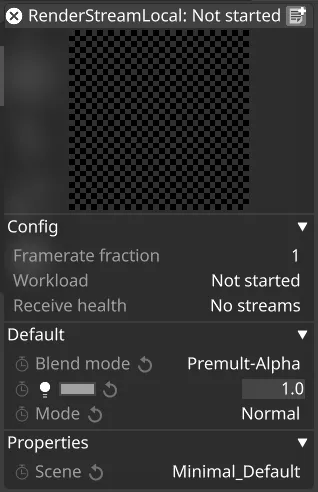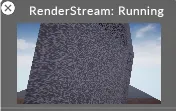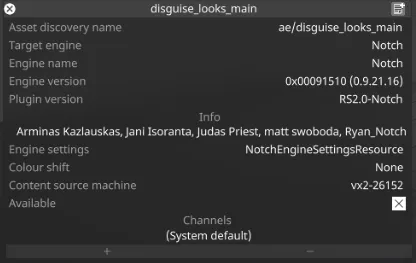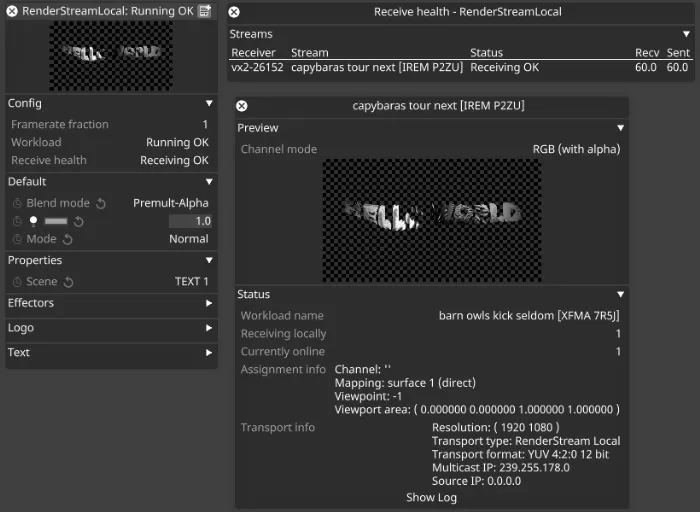RenderStream Local Layer
The RenderStream Local Layer is used to control third-party render engines running externally to Designer locally on a VX or GX server.
At this time, the VX 4 and VX 4+ do not currently support RenderStream Local, as further development work is needed for AMD GPU support.
The RenderStreamLocal layer is a local RenderStream mode used to sequence instances of Unreal Engine, Unity, and TouchDesigner using the same RenderStream plugins as RenderStream in remote mode. Support for Notch is built into Designer.

There are four main sections within the RenderStreamLocal Layer:
- Media Thumbnail
- Config
- Default
- Properties
Media Thumbnail
Section titled “Media Thumbnail”This area will display an image of the active stream being received. Note that in a multi-channel environment, this will only show the Camera in UE that has the RS component attached to it.

Configuration
Section titled “Configuration”This section describes the configuration properties, real-time workload monitoring and engine health monitoring.

Cluster Workload
Section titled “Cluster Workload”
The Cluster Workload window contains the elements required for configuring a workload. It contains Configure and Control sections.
Configure
Section titled “Configure”The Configure section contains elements to set up a workload.
This is the Render Engine project or Notch block that will be controlled by the layer. In order for the asset to be visible here, it must be present in the RenderStream projects folder of the render machines.
Right-click on the asset name to open the Asset properties editor:

Properties include:
- Asset discovery name: Name of the folder/project.
- Target engine: Name of the Render Engine.
- Engine version: Engine version.
- Plugin version: Plugin version.
- Engine settings: Engine-specific settings.
- Colour shift: Apply colour correction to the entire asset.
- Content source machine: The render machine that is running the render engine project. This is the machine that the project will be synced from.
- Available: Status indicator displaying if the Asset is available. Not a tick box.
- Channels: Active channels defined in the render engine project.
Channel Mappings
Section titled “Channel Mappings”Channel Mappings include properties such as:
- Channel: active channel, editable field.
- Mapping: active mapping, editable field.
- Render Nodes: non-editable list of render machines.
Control
Section titled “Control”The Control section allows for managing the workload.
-
Instances: When started, the Instances table will be populated with the machines that have been sent the start signal.
-
Start: sends a signal to all machines in the Render Nodes list to launch the Asset according to config settings.
-
Stop: Sends a signal to cease outputting a stream and quit the process sending it. The workload log can be opened by left-clicking on the status within the Instances table
-
Sync: begins the process of content sync. Content is synced from the source machine to all other available Render Nodes; it copies only the necessary directories and files needed.
With r31.0.3, a new workload status has been added to show sync progress (in progress, complete, failed) on the RenderStream Local layer.

Receive Health
Section titled “Receive Health”The statuses of all render machines are dynamically reported while the stream is running.
Right-click on Receive health to open the machine-specific window:

Default
Section titled “Default”In the Default section of the RenderStreamLocal Layer, there are four common layer properties:

- Blend Mode: Premult-Alpha is needed for content that contains alpha data.
- Brightness: Layer intensity.
- Mode: This is used to determine the timeline’s playback behaviour as the layer is playing.
Properties Section
Section titled “Properties Section”The last section of the RenderStreamLocal layer is asset-specific and will display all exposed parameters from the asset, as well as their keyframe editors

Transport Format Differences
Section titled “Transport Format Differences”RenderStream Local operates exclusively at the highest transport quality supported by Designer. Unlike remote RenderStream workflows, the transport format is fixed and cannot be adjusted.
Key characteristics are as follows:
- YUV 12-bit is always used and is the only supported transport format.
- 8-bit and 10-bit transport formats are not supported in RenderStream Local.
- Alpha is enabled by default and is always included in the stream.
Render Engine Workflows
Section titled “Render Engine Workflows”Set up your environment, including installation of the Render Engine and required plugin.
Use the RenderStreamLocal Layer to control the third-party render engine.
- Notch
- Plugin - included in Designer.
- Documentation
- Touch Designer
- Unity
- Unreal Engine